When you form a PN junction you're basically closing a circuit so why don't the free electrons in the N and the holes in the P diffuse completely as they would in any other circuit?

When you form a PN junction you're basically closing a circuit so why don't the free electrons in the N and the holes in the P diffuse completely as they would in any other circuit?

Your first pictures show only the 'free moving' things: both parts are electrically neutral: they contain an amount of kernels (with a lot of layer-layer electrons) that compensate the free moving parts. The electrostatic force forces the free moving thingies and their kernels together. (But the kernels can't move, so its the free moving thingies that are more or less bound to their location.)
But in the boundary layer the free moving thingies have to move only a very small distance to annul each other, so that is what happens: a small region where the attraction of the freem moving thingies overcome them being attracted to their 'homes'.
These homes can't move, so the missing free moving thingies leave a small region on each side of the boundary that is charged and is lacking any free moving thingies (hence: an isolator).
"Why do they stop diffusing"? Because they are attracted ('bound') by the atom kernels they originated from.
Electrons need free electrons near by to more. In the depletion layer all the atoms are complete and have no free electrons left within.
To over come this the electrons require extra energy, which is absent and the absorption stops
For the same reason the charges of a capacitor’s plates face the opposite plate in a thin layer and don’t diffuse. The bulk of either capacitor’s plates or diode is conductive, whereas conductors don’t tolerate charges inside them. A significant space charge is needed to transform the electron band structure to such an extent that a normally conductive material becomes an insulator.